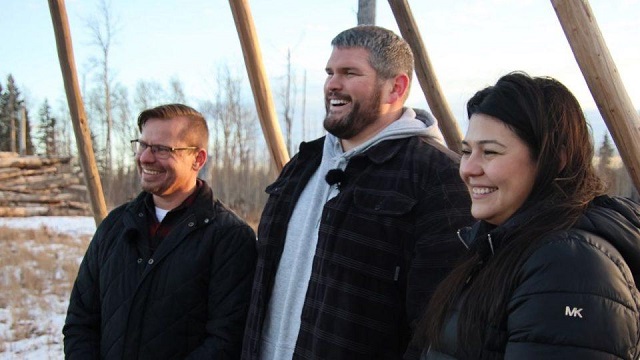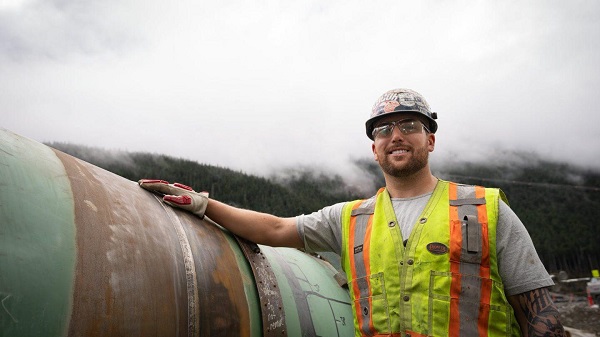Canadian Energy Centre
Why Canada’s proposed oil and gas emissions cap goes against UNDRIP and the rights of Indigenous people

Indigenous Resource Network executive director John Desjarlais (centre), with Justin Bourque, president of Âsokan Generational Developments, and Shelby Kennedy, community and Indigenous relations advisor with Enbridge. Photo courtesy Indigenous Resource Network
From the Canadian Energy Centre
Q&A with John Desjarlais, executive director of the Indigenous Resource Network
The Indigenous Resource Network (IRN) is pushing back on Canada’s proposed framework to cap emissions from the oil and gas sector.
IRN executive director John Desjarlais says the proposal directly contradicts Canada’s support for the United Nations Declaration on the Rights of Indigenous People (UNDRIP).
He says the plan would cap opportunity for Indigenous communities as more take on ownership positions in major energy projects from oil and gas pipelines to liquefied natural gas terminals and carbon capture and storage projects.
Here’s what Desjarlais told CEC.
CEC: From the perspective of Indigenous communities across Canada who are involved in natural resources development, what’s your take on the federal government’s proposed oil and gas emissions cap?
John Desjarlais: There’s a lot of confidence that it will curtail production as well, and obvious concern that it’s going to mean less opportunity.
We’ve heard from communities that are saying we’re involved already in emissions reduction. There are communities that just want to advance their opportunities in that space. And it’s at a time when there’s probably the greatest appetite for Indigenous involvement, not just in ownership, but advanced business development and procurement. [It could] mean less jobs, less procurement, less ownership opportunity, less investment.
There are concerns that these impacts are not being heavily understood, measured, contemplated or considered in terms of the policy development and implementation.
CEC: How does being involved in oil and gas development benefit Indigenous communities?
JD: There’s a suite of benefits that are coming from increased engagement, and it’s much deeper than just jobs.
Communities are now jumping into revenue generating assets where they’re creating immediate cash flow, which is allowing them to start to self-determine and invest back into their community either through economic development or through infrastructure programming.
The other side to it is just the capacity that comes from being involved as an owner. Indigenous business and community leaders are being exposed to the requirements and the acumen needed to successfully participate in the ownership of decision making. That’s accelerating the development of the acumen and capacity of different indigenous communities at greater rates
CEC: How many communities would you estimate are now participating at this level?
JD: There’s probably upwards directly of at least 100 different communities now. There are double-digit communities that are involved in at least four or five different deals that are directly involved in the ownership and the benefit side, and then there’s cascading involvement of all the surrounding communities through procurement opportunities and employment. It’s growing quite quickly.
CEC: Why do you say the proposed emissions cap contradicts the United Nations Declaration on the Rights of Indigenous People?
It’s a policy that’s created to achieve certain goals. Creating those types of targets without Indigenous oversight – not just input, [but] oversight and ownership – is problematic because it contradicts the UNDRIP action plan in terms of stepping out of the way of affording Indigenous peoples and communities the ability to self-determine; to invest where they want to invest, and to grow how they want to grow.
We hear a lot of community leaders say, ‘we know what’s best for our territories.’ To have policy that limits our ability to make the decisions we want to make in regard to environmental and economic sustainability is a challenge.
CEC: What would you like to see happen?
JD: It’s a little hard to roll back and involve communities in a total redesign, but at least if we saw an understanding that there’s certainly going to be an economic impact. If there’s a production cap aspect to it, there’s going to be an economic impact to those Indigenous communities that have established livelihoods and revenue streams.
There’s the sentiment that if the government truly is advancing this in the direction that they are, then would they consider omission of Indigenous activity so they can continue advancing their economic interests and growth?
Ideally, [there would be] a policy that’s created in line with UNDRIP that works for communities, industries and governments in their goals.
2025 Federal Election
Canada’s pipeline builders ready to get to work

From the Canadian Energy Centre
“We’re focusing on the opportunity that Canada has, perhaps even the obligation”
It was not a call he wanted to make.
In October 2017, Kevin O’Donnell, then chief financial officer of Nisku, Alta.-based Banister Pipelines, got final word that the $16-billion Energy East pipeline was cancelled.
It was his job to pass the news down the line to reach workers who were already in the field.
“We had a crew that was working along the current TC Energy line that was ready for conversion up in Thunder Bay,” said O’Donnell, who is now executive director of the Mississauga, Ont.-based Pipe Line Contractors Association of Canada (PLCAC).
“I took the call, and they said abandon right now. Button up and abandon right now.
“It was truly surreal. It’s tough to tell your foreman, who then tells their lead hands and then you inform the unions that those three or four or five million man-hours that you expected are not going to come to fruition,” he said.

Workers guide a piece of pipe along the Trans Mountain expansion route. Photograph courtesy Trans Mountain Corporation
“They’ve got to find lesser-paying jobs where they’re not honing their craft in the pipeline sector. You’re not making the money; you’re not getting the health and dental coverage that you were getting before.”
O’Donnell estimates that PLCAC represents about 500,000 workers across Canada through the unions it works with.
With the recent completion of the Trans Mountain expansion and Coastal GasLink pipelines – and no big projects like them coming on the books – many are once again out of a job, he said.
It’s frustrating given that this could be what he called a “golden age” for building major energy infrastructure in Canada.
Together, more than 62,000 people were hired to build the Trans Mountain expansion and Coastal GasLink projects, according to company reports.
O’Donnell is particularly interested in a project like Energy East, which would link oil produced in Alberta to consumers in Eastern and Atlantic Canada, then international markets in the offshore beyond.
“I think Energy East or something similar has to happen for millions of reasons,” he said.
“The world’s demanding it. We’ve got the craft [workers], we’ve got the iron ore and we’ve got the steel. We’re talking about a nation where the workers in every province could benefit. They’re ready to build it.”

The “Golden Weld” marked mechanical completion of construction of the Trans Mountain Expansion Project on April 11, 2024. Photo courtesy Trans Mountain Corporation
That eagerness is shared by the Progressive Contractors Association of Canada (PCA), which represents about 170 construction and maintenance employers across the country.
The PCA’s newly launched “Let’s Get Building” advocacy campaign urges all parties in the Canadian federal election run to focus on getting major projects built.
“We’re focusing on the opportunity that Canada has, perhaps even the obligation,” said PCA chief executive Paul de Jong.
“Most of the companies are quite busy irrespective of the pipeline issue right now. But looking at the long term, there’s predictability and long-term strategy that they see missing.”
Top of mind is Ottawa’s Impact Assessment Act (IAA), he said, the federal law that assesses major national projects like pipelines and highways.
In 2023, the Supreme Court of Canada found that the IAA broke the rules of the Canadian constitution.
The court found unconstitutional components including federal overreach into the decision of whether a project requires an impact assessment and whether a project gets final approval to proceed.
Ottawa amended the act in the spring of 2024, but Alberta’s government found the changes didn’t fix the issues and in November launched a new legal challenge against it.
“We’d like to see the next federal administration substantially revisit the Impact Assessment Act,” de Jong said.
“The sooner these nation-building projects get underway, the sooner Canadians reap the rewards through new trading partnerships, good jobs and a more stable economy.”
Canadian Energy Centre
First Nations in Manitoba pushing for LNG exports from Hudson’s Bay

From the Canadian Energy Centre
By Will Gibson
NeeStaNan project would use port location selected by Canadian government more than 100 years ago
Building a port on Hudson’s Bay to ship natural resources harvested across Western Canada to the world has been a long-held dream of Canadian politicians, starting with Sir Wilfred Laurier.
Since 1931, a small deepwater port has operated at Churchill, Manitoba, primarily shipping grain but more recently expanding handling of critical minerals and fertilizers.
A group of 11 First Nations in Manitoba plans to build an additional industrial terminal nearby at Port Nelson to ship liquefied natural gas (LNG) to Europe and potash to Brazil.
Robyn Lore, a director with project backer NeeStaNan, which is Cree for “all of us,” said it makes more sense to ship Canadian LNG to Europe from an Arctic port than it does to send Canadian natural gas all the way to the U.S. Gulf Coast to be exported as LNG to the same place – which is happening today.
“There is absolutely a business case for sending our LNG directly to European markets rather than sending our natural gas down to the Gulf Coast and having them liquefy it and ship it over,” Lore said. “It’s in Canada’s interest to do this.”
Over 100 years ago, the Port Nelson location at the south end of Hudson’s Bay on the Nelson River was the first to be considered for a Canadian Arctic port.
In 1912, a Port Nelson project was selected to proceed rather than a port at Churchill, about 280 kilometres north.
The Port Nelson site was earmarked by federal government engineers as the most cost-effective location for a terminal to ship Canadian resources overseas.
Construction started but was marred by building challenges due to violent winter storms that beached supply ships and badly damaged the dredge used to deepen the waters around the port.
By 1918, the project was abandoned.
In the 1920s, Prime Minister William Lyon MacKenzie King chose Churchill as the new location for a port on Hudson’s Bay, where it was built and continues to operate today between late July and early November when it is not iced in.
Lore sees using modern technology at Port Nelson including dredging or extending a floating wharf to overcome the challenges that stopped the project from proceeding more than a century ago.
He said natural gas could travel to the terminal through a 1,000-kilometre spur line off TC Energy’s Canadian Mainline by using Manitoba Hydro’s existing right of way.
A second option proposes shipping natural gas through Pembina Pipeline’s Alliance system to Regina, where it could be liquefied and shipped by rail to Port Nelson.
The original rail bed to Port Nelson still exists, and about 150 kilometers of track would have to be laid to reach the proposed site, Lore said.
“Our vision is for a rail line that can handle 150-car trains with loads of 120 tonnes per car running at 80 kilometers per hour. That’s doable on the line from Amery to Port Nelson. It makes the economics work for shippers,” said Lore.
Port Nelson could be used around the year because saltwater ice is easier to break through using modern icebreakers than freshwater ice that impacts Churchill between November and May.
Lore, however, is quick to quell the notion NeeStaNan is competing against the existing port.
“We want our project to proceed on its merits and collaborate with other ports for greater efficiency,” he said.
“It makes sense for Manitoba, and it makes sense for Canada, even more than it did for Laurier more than 100 years ago.”
-

 2025 Federal Election2 days ago
2025 Federal Election2 days agoOttawa Confirms China interfering with 2025 federal election: Beijing Seeks to Block Joe Tay’s Election
-

 2025 Federal Election1 day ago
2025 Federal Election1 day agoBREAKING: THE FEDERAL BRIEF THAT SHOULD SINK CARNEY
-

 COVID-192 days ago
COVID-192 days agoNearly Half of “COVID-19 Deaths” Were Not Due to COVID-19 – Scientific Reports Journal
-

 2025 Federal Election2 days ago
2025 Federal Election2 days agoHow Canada’s Mainstream Media Lost the Public Trust
-

 John Stossel1 day ago
John Stossel1 day agoClimate Change Myths Part 2: Wildfires, Drought, Rising Sea Level, and Coral Reefs
-

 2025 Federal Election1 day ago
2025 Federal Election1 day agoCHINESE ELECTION THREAT WARNING: Conservative Candidate Joe Tay Paused Public Campaign
-

 Media1 day ago
Media1 day agoCBC retracts false claims about residential schools after accusing Rebel News of ‘misinformation’
-

 2025 Federal Election2 days ago
2025 Federal Election2 days agoReal Homes vs. Modular Shoeboxes: The Housing Battle Between Poilievre and Carney









